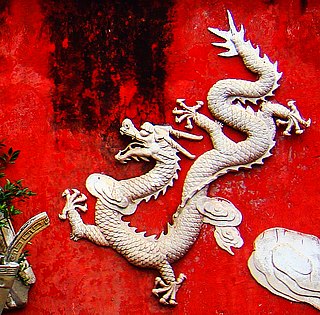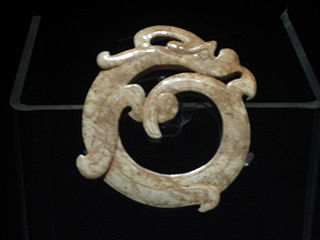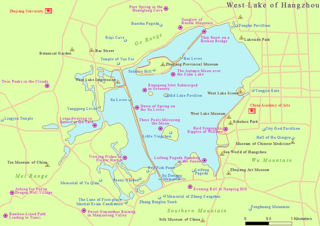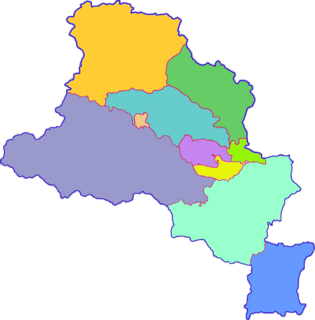
Chinese dragons, also known as East Asian dragons, are legendary creatures in Chinese mythology, Chinese folklore, and East Asian culture at large. Chinese dragons have many animal-like forms such as turtles and fish, but are most commonly depicted as snake-like with four legs. They traditionally symbolize potent and auspicious powers, particularly control over water, rainfall, typhoons, and floods. The dragon is also a symbol of power, strength, and good luck for people who are worthy of it in East Asian culture. During the days of Imperial China, the Emperor of China usually used the dragon as a symbol of his imperial power and strength.

Panlong is an aquatic dragon resembling a jiaolong 蛟龍 "river dragon; crocodile" in Chinese mythology, an ancient motif in Chinese art, and a proper name.
Longmen may refer to the following:

Huanglong is a scenic and historic interest area in the northwest part of Sichuan, China. It is located in the southern part of the Minshan mountain range, 370 kilometres (230 mi) north-northwest of the capital Chengdu. This area is known for its colorful pools formed by calcite deposits, especially in Huanglonggou, as well as diverse forest ecosystems, snow-capped peaks, waterfalls and hot springs. Huanglong is also home to many endangered species including the giant panda and the Sichuan golden snub-nosed monkey. Huanglong was declared a World Heritage Site by UNESCO in 1992.

Longjing, literally "dragon well", is a name applied to a number of locations and products from the southwestern region of the city of Hangzhou in Zhejiang province, China. Most notably, the name refers to the titular Dragon Well itself, located near Longjing village in Xihu District, as well as the area encompassing the well and the Longjing tea famously grown there.

Kids From Shaolin, also known as Shaolin Temple 2: Kids From Shaolin, is a 1984 Hong Kong-Chinese kung fu comedy film directed by Chang Hsin-yen.
Shenlong is a prototype Chinese robotic spaceplane that is similar to the American Boeing X-37. Only a few pictures have appeared since it was revealed in late 2007.

Longhu District is a district of Shantou, Guangdong province, China.

Shilong District is a district of the city of Pingdingshan, Henan, China.

Yunlong District is one of six districts of Xuzhou, Jiangsu province, China.
Shuanghedong (双河洞), is the longest cave in China, in Asia, and the 6th longest in the world in 2018.
Tenglong Cave is a cave located 6.8 km (4.2 mi) from Lichuan City, Hubei, China. It is believed to be the longest monomer karst cave system in the world. The cave entrance is 74 m (243 ft) and 64 m (210 ft) wide, leading to 59.8 km (37.2 mi) of passageways. An underground network of streams runs for 16.8 km (10.4 mi) whilst the cave is the source of the Qingjiang River. Year round temperatures underground remain in the 16–18 degrees Celsius range.

Huanglong Cave is a karst cave located near the Wulingyuan district of Zhangjiajie City, Hunan, People's Republic of China and a national 4A rated scenic area. As of 2010, the cave has over a million visitors per year. Since 1997, the Huanglong Cave scenic area has been managed by Beijing-based China Datong Co. Ltd. It was previously managed directly by the Hunan provincial government.

The Three Natural Bridges are a series of natural limestone bridges located in Xiannüshan Town (仙女山镇), Wulong District, Chongqing Municipality, China. They lie within the Wulong Karst National Geology Park, itself a part of the South China Karst-Wulong Karst UNESCO World Heritage Site. In Chinese, the bridges are all named after dragons, namely Tianlong Qinglong and Heilong.
The Wulong Karst is a karst landscape located within the borders of Wulong County, Chongqing Municipality, People's Republic of China. It is divided into three areas containing the Three Natural Bridges, the Qingkou Tiankeng (箐口天坑) and Furong Cave respectively. It is a part of the Wulong Karst National Geology Park as well as part of the South China Karst, a UNESCO World Heritage Site.
Shuanlong Cave is a water-filled karst cave some 8 km (5.0 mi) from Jinhua City, Zhejiang Province, People's Republic of China.
Binghu Cave is a karst cave located some 8 km (5.0 mi) from Jinhua City, Zhejiang Province, People's Republic of China.

Taiji Cave is a karst cave located on Shilong Mountain (石龙山) in Guangde County, Xuancheng City, Anhui Province, People's Republic of China, where the provinces of Jiangsu, Zhejiang and Anhui meet. Ming Dynasty writer and poet Feng Menglong described the cave as one of the "Four Absolutes Under Heaven". It is also considered a primary "Place of Enlightenment" by Taoists, similar to the Bodhimanda of Buddhism. The 200-million-year-old cave is divided into dry and wet layers representing the yin and yang of Chinese philosophy.
In February 2004, the Chinese State Council included the cave on its fifth list of National Scenic Attractions. It is also a 4A rated National Tourism Area.

Longdong Town is an urban town in Xiangxiang City, Xiangtan City, Hunan Province, People's Republic of China.













